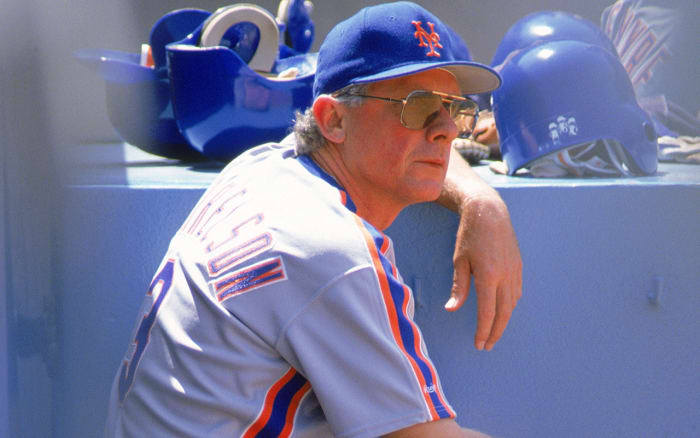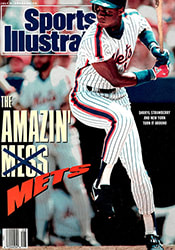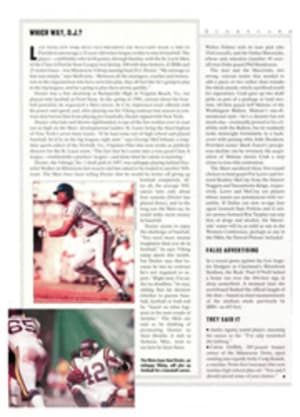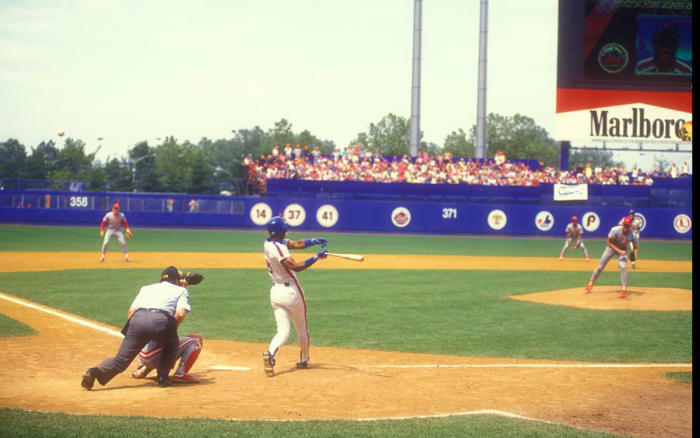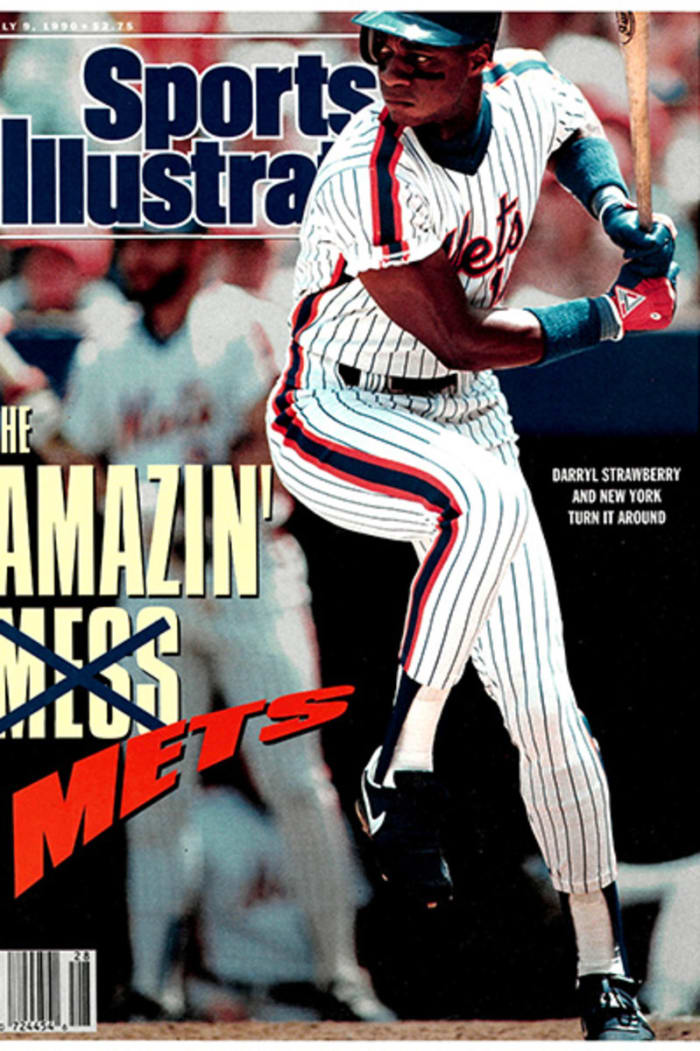A Cool Bud and Some Red-Hots
Bud Harrelson was poised at the rim of a mug of beer roughly the size of an industrial-waste drum. He was behind his desk in the manager's office at Shea Stadium in New York last Friday night, but so large was his post game brew that it looked as if he were sitting poolside. Harrelson's Mets had just beaten the Cincinnati Reds 4–2 for their 11th straight victory, a winning streak that tied a team record also matched by the 1969 and 1986 world champions, and suddenly Harrelson paused before attempting to clean-and-jerk the cold one before him.
“Sixty-nine and '86,” he said while watching waves of barley lap at the mug's edges.“Vintage years.”
If the Mets of '69 and '86 were celebratory bottles of bubbly, then the '90 team is embodied by a very cool Bud. Since Harrelson replaced the fired Davey Johnson on May 29—when New York was 20–22, in fourth place in the National League East—the Mets, through Sunday, have been on a 22–8 binge. Their 21 victories in Harrelson's first full month on the job was the Mets' best June ever and their winningest month since they won 23 games in September '69. With the victory on Friday night and Pittsburgh's loss hours later in San Francisco, the Mets assumed for one night—by three percentage points—what they believe is their rightful position atop the division.
Alcoholic-beverage analogies aside, though, the biggest difference between the 1990 team managed by Harrelson and one from his days as a Mets shortstop are the teams' respective slogans. In '73 it was You Gotta Believe; this season, You Don't Gotta Believe. You certainly don't gotta believe everything you read, least of all “that rip job,” as Mets vice-president of baseball operations Joe McIlvaine termed SPORTS ILLUSTRATED'S last story on the Mets (Amazin' Mess, June 11), which buried the team beneath the rubble of alleged front-office failings.
You don't gotta believe the man in the street's lust to hear the rumble of front-office heads rolling down the ramps at Shea. “What's important,” says pitcher Bob Ojeda, “is how the man in the uniform feels.”
And lastly, you don't gotta believe everything the Mets might tell you, because they might not believe it themselves. Early in the season, pitcher Dwight Gooden spoke for several Mets when he said that the front office had dealt every player-spark plugs like Lenny Dykstra and Wally Backman—“who used to snap.”
“I still think it's good to have [those players],” Gooden said Saturday, when the Mets' 7–4 loss to the Reds ended the 11-game winning streak as well as a run of 10 straight victories at home. “But sometimes that can be overrated. Everyone who has made it here should know by now what they have to do to win.”
“There are a lot of teams that win without the big spark plug,” says first baseman Dave Magadan. “Oakland didn't have one two years ago, before they got Rickey Henderson, and they made it to the World Series.”
Which, it must now be conceded, is a distinct possibility for the Mets come autumn. Their weekend series with Cincinnati, runaway leaders of the National League West,had the look of early October. With a 3–2 victory on Sunday, the Mets took the four-game series three games to one and were just a game behind Pittsburgh,which had regained first place Saturday night. Even earlier last week, with the Mets still No. 3 with a bullet behind Pittsburgh and Montreal, Expo pitcher Dennis Martinez acknowledged, “We're all still looking at the Mets as the team to beat.”
Of course, some rather significant questions remain. For instance: Has the amazin' mess really been mopped clean or merely swept under a throw rug? And if the heap has been hauled away for good, how did the Mets make the cleanup so quickly? Finally, can the people at Exxon learn anything from all of this?
For answers, we begin by checking the pulse of the team, registered in the wrists of rightfielder Darryl Strawberry. When he hit .247 with seven homers and 19 RBIs in the first two months of the season, a Straw seemed the perfect symbol for a team that sucked wind. After Johnson was fired, Strawberry himself announced his intention to leave New York when he becomes a free agent at the end of this season.
But on June 8,the Straw started stirring, 2 for 4 with two home runs and four RBIs against Pittsburgh, and he hit safely in the next 17 games. He had nine home runs and 24 RBIs during the hitting streak, which ended Saturday. In June, he hit .376with 10 home runs and 27 RBIs, and as of Sunday his season stats were up to.293, 17 and 46. On a team that of late has seen more streaks than Madonna's hairdresser, Strawberry's was perhaps the most important, for Darryl is now happy and is willing to talk contract with general manager Frank Cashen.
As his teammates bustle around the clubhouse in Harrelson-issued T-shirts that read LOOSIE GOOSIE, Strawberry gabs graciously about what appears to be ancient history. “There were a lot of unhappy campers here in the beginning,” he says.“But we've pulled together and are so close now. Everybody pats each other on the back, picks each other up. Buddy has a lot to do with it. It helps that other guys get to play.”
To hear many of the Mets now tell it, the lineup card may as well have been laminated when Johnson was manager. Harrelson, however, has taken over with a tabula rasa. The primary beneficiaries of the Buddy system are Magadan, who has replaced Mike Marshall as the starting first baseman; Mark Carreon, who now gets consistent time in the outfield; and Daryl Boston, who can comfort himself with the knowledge that he will be in the outfield against right handed pitchers.
When they were struggling early, the Mets were particularly weak up the middle, with a second baseman, Keith Miller, playing centerfield and no catcher performing well enough to take over the starting job. But a platoon of Carreon (.274, eight homers) and Boston (.280, five homers) has made the Mets solid in center, and catcher Mackey Sasser's overall play improved steadily when he began playing regularly after Barry Lyons was sidelined by a back injury. In addition to raising his average to .320, Sasser threw out 12 of 34 base runners attempting to steal against the Mets during the past four weeks, including St. Louis's Vince Coleman, thereby ending his streak of 57 straight thefts against the Mets.
Marshall, who has pitched the newest tent in the Mets' tiny Unhappy Camp, was simply Wally Pipped: Since Marshall injured his back in early June, Magadan has hit .379 as the starter, a role in which he now feels secure. “The first two games of[the Cincinnati] series, I didn't get a hit,” says Magadan, who went 2 for 6 in the next two games. “Instead of going home with a horrible attitude, thinking I'm not going to play for a week, I know now I'll get another chance the next day.”
“More guys in there translates to a more aggressive group,” says Ojeda. “It's not just eight or nine aggressive guys.” It helps that pitchers David Cone,John Franco and Ojeda, and third baseman Howard Johnson all have had a single racing stripe shaved just above their sideburns, a move calculated to make these Mets at least look nastier. (It doesn't take much in Cone's case, but it is quite a feat for Franco and HoJo.)
Six weeks ago,when there was an almost obligatory silence in the Shea clubhouse, the team 'do would have been a team don't. “We were struggling, and I was struggling myself,” says Gooden, who has won his last four starts and is now 7-4. “Every day you had to come here and answer the question, What's wrong? Everybody had a different story. You dwell on it, and it takes a toll.”
What was wrong,the Mets front office decided, was not the Mets front office. “I've always said that a team reflects the personality of its manager,” says McIlvaine. “Davey, when he first came up, was a ball of fire. Then, for whatever reason, that changed.” Peering in the rearview mirror, it is as convenient to condemn Johnson now as it was to condemn McIlvaine & Co. in May. Harrelson has made the issue of blame irrelevant and certainly has kept things loosie goosie.
Before any game, the 46-year-old manager can be seen taking infield practice-he delights in fetching a second baseman and turning the first two-thirds of a 4-6-3 double play—or tossing batting practice. His most prominent office decoration is a mock National Enquirer cover (NEW SKIPPER'S AMAZING PSYCHIC PREDICTION—'90 WORLD SERIES...AT SHEA!).
But how long Harrelson remains stress-free depends on the team, which, Harrelson admits, he couldn't possibly have screwed up during the streak. So once again, with the Mets having returned to earth, one must ask: Is the assembled talent good enough to win a World Series? In accordance with the equal-time laws that govern coverage of presidential campaigns and pennant races, we present this month's version of the Mets' response.
“We've thought that all along,” says McIlvaine, who believes he and Cashen were portrayed as “buffoons and fools” when Johnson was fired. At about that time, says Magadan, “we more or less had the attitude that we're too talented, and the season's too long, for us to give up after 50 games.” Now, says Sasser, “we don't think there's a team in the league that can beat us.”
But if you want to know how many Mets really thought a month and a half ago that they had the talent to win their division, much less a World Series ring, you'll have to call Kreskin. As Ojeda says, “It's simple now to say we've got a very good or great ball club.”
Simple but accurate. That the Mets are at the least very good is the only possible conclusion. “In '86 we had [Gary] Carter and [Keith] Hernandez and veteran-type players,” says McIlvaine. “We've made the transition to a young team—look, there's a young infield and a young outfield—without dropping in the standings. That's good management. I'm not trying to blow our own horn but....”
But somebody has to, for all is right again at Shea. On Saturday the Mets had their largest crowd of the season, 49,128. The roar in the stadium—even the chants of DAR-ryl have been revived—is no longer the exclusive courtesy of commercial aircraft. The more spirited fans are once again their surly selves, engaging each other in between-innings bare-knuckle brawls and even offering up solitary boos for local ice-cream company mascot Fudgie the Whale, a sort of Sid Fernandez with dorsal fins, who threw out the first ball on Saturday.
In the clubhouse,the pennant-race tune-up is even more palpable. Last weekend Harrelson found himself turning to the Pirate-Giants games on his enormous office television set immediately after his own games were over. Shortstop Kevin Elster is religiously watching ESPN for updates on the Pirates, though he said on Saturday that he would stop short of calling San Francisco manager Roger Craig at Candlestick Park. “Did you win?” Elster imagined himself, aloud, asking Craig in a phone call. “You what?! You brought in who?!”
Of course, the Mets must occasionally remind themselves and their legion of local media that it's only July and that pennant fever is premature. Hey, hold your questions for September. Questions like, Would Bud Harrelson be the first manager to forgo a champagne shower to bathe himself in a mug of beer?
